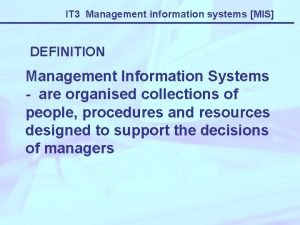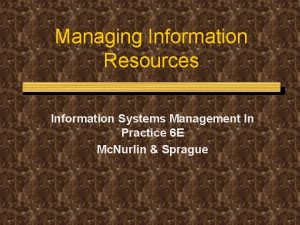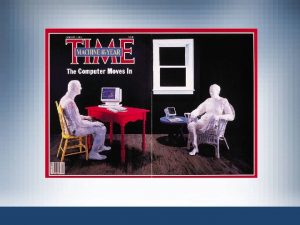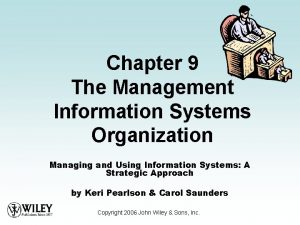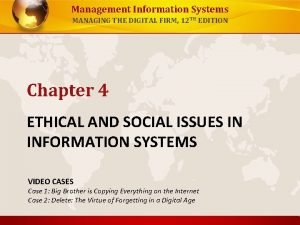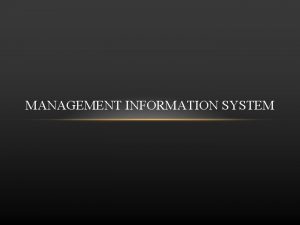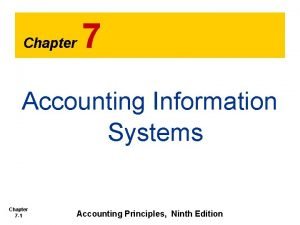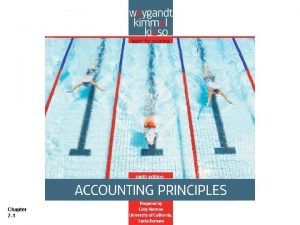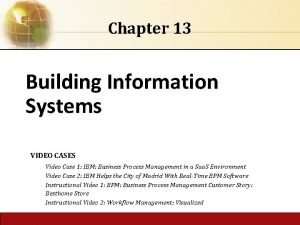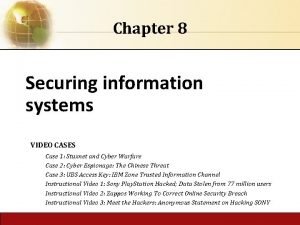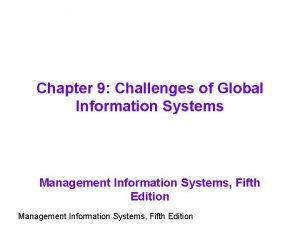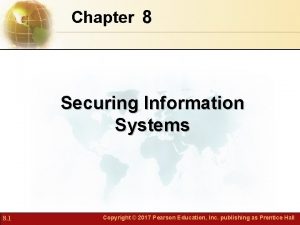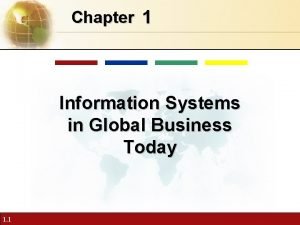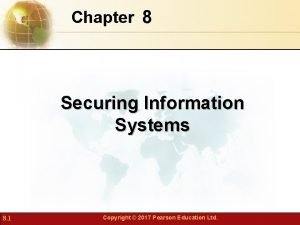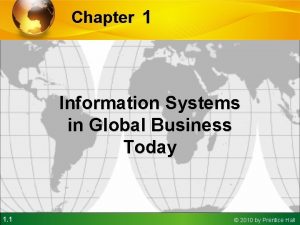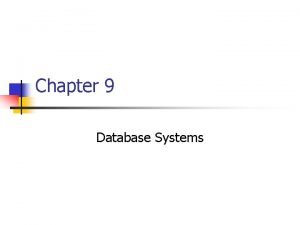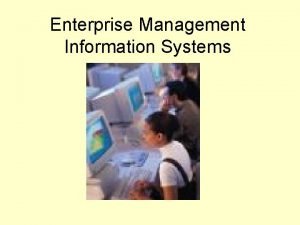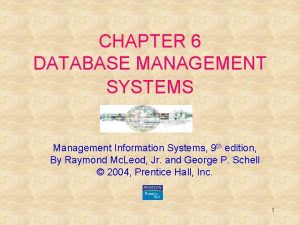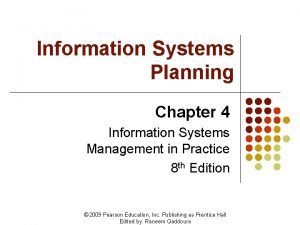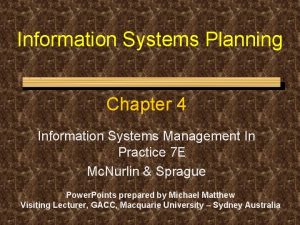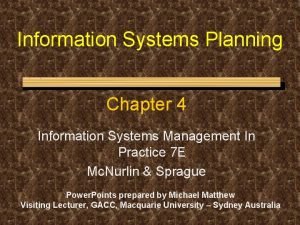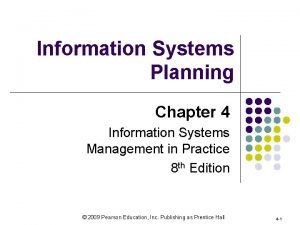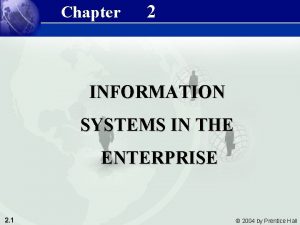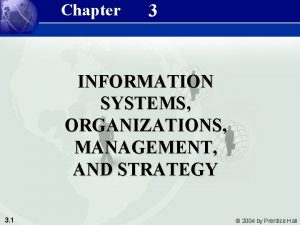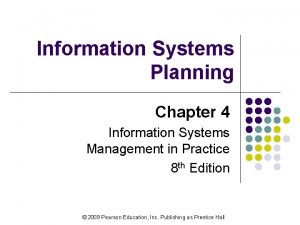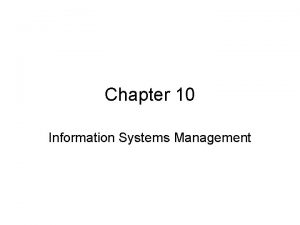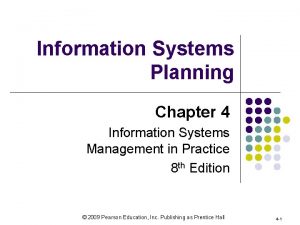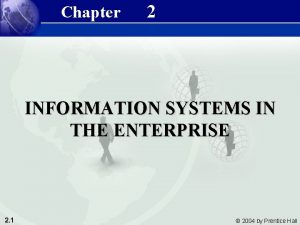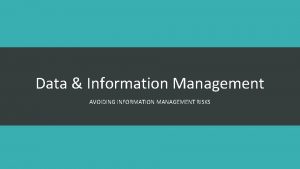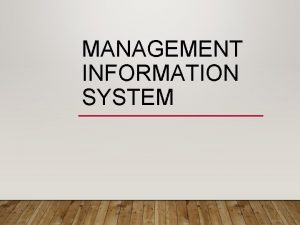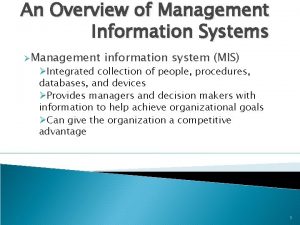Management Information Systems 8e Chapter 2 Information Systems

































- Slides: 33

Management Information Systems 8/e Chapter 2 Information Systems in the Enterprise ENTERPRISE INFORMATION SYSTEMS & BUSINESS PROCESSES BY Saurabh Goel IBS Chennai 2. 1 © 2004 by Prentice Hall

Management Information Systems 8/e Chapter 2 Information Systems in the Enterprise OBJECTIVES • What are the major types of systems in a business? What role do they play? • How do information systems support the major business functions? • Why should managers pay attention to business processes? 2. 2 © 2004 by Prentice Hall

Management Information Systems 8/e Chapter 2 Information Systems in the Enterprise OBJECTIVES • What are the benefits and challenges of using enterprise systems? • What are the benefits of using systems to support supply chain management and collaborative commerce? • What are the benefits of using information systems for customer relationship management and knowledge management? 2. 3 © 2004 by Prentice Hall

Management Information Systems 8/e Chapter 2 Information Systems in the Enterprise MANAGEMENT CHALLENGES 1. Integration: Different systems serve variety of functions, connecting organizational levels difficult, costly 2. Enlarging scope of management thinking: Huge system investments, long development time must be guided by common objectives 2. 4 © 2004 by Prentice Hall

Management Information Systems 8/e Chapter 2 Information Systems in the Enterprise KEY SYSTEM APPLICATIONS IN THE ORGANIZATION Types of Information Systems 2. 5 Figure 2 -1 © 2004 by Prentice Hall

Management Information Systems 8/e Chapter 2 Information Systems in the Enterprise MAJOR TYPES OF SYSTEMS IN ORGANIZATIONS 2. 6 © 2004 by Prentice Hall

Management Information Systems 8/e Chapter 2 Information Systems in the Enterprise ENTERPRISE APPLICATIONS Business Processes and Information Systems Business processes • Manner in which work is organized, coordinated, and focused to produce a valuable product or service • Concrete work flows of material, information, and knowledge—sets of activities 2. 7 © 2004 by Prentice Hall

Management Information Systems 8/e Chapter 2 Information Systems in the Enterprise ENTERPRISE APPLICATIONS Business Processes and Information Systems • Unique ways to coordinate work, information, and knowledge • Ways in which management chooses to coordinate work 2. 8 © 2004 by Prentice Hall

Management Information Systems 8/e Chapter 2 Information Systems in the Enterprise ENTERPRISE APPLICATIONS Business Processes and Information Systems Information systems help organizations • Achieve great efficiencies by automating parts of processes • Rethink and streamline processes 2. 9 © 2004 by Prentice Hall

Management Information Systems 8/e Chapter 2 Information Systems in the Enterprise ENTERPRISE APPLICATIONS Examples of Business Processes • Manufacturing and production: Assembling product, checking quality, producing bills of materials • Sales and marketing: Identifying customers, creating customer awareness, selling 2. 10 © 2004 by Prentice Hall

Management Information Systems 8/e Chapter 2 Information Systems in the Enterprise ENTERPRISE APPLICATIONS Examples of Business Processes • Finance and accounting: Paying creditors, creating financial statements, managing cash accounts • Human Resources: Hiring employees, evaluating performance, enrolling employees in benefits plans 2. 11 © 2004 by Prentice Hall

Management Information Systems 8/e Chapter 2 Information Systems in the Enterprise ENTERPRISE APPLICATIONS Business Processes and Information Systems Cross-Functional Business Processes • Transcend boundary between sales, marketing, manufacturing, and research and development • Group employees from different functional specialties to a complete piece of work Example: Order Fulfillment Process 2. 12 © 2004 by Prentice Hall

Management Information Systems 8/e Chapter 2 Information Systems in the Enterprise ENTERPRISE APPLICATIONS The Order Fulfillment Process Figure 2 -12 2. 13 © 2004 by Prentice Hall

Management Information Systems 8/e Chapter 2 Information Systems in the Enterprise ENTERPRISE APPLICATIONS Enterprise Applications • Enterprise systems • Supply chain management systems • Customer relationship management systems • Knowledge management systems 2. 14 © 2004 by Prentice Hall

Management Information Systems 8/e Chapter 2 Information Systems in the Enterprise ENTERPRISE APPLICATIONS Traditional View of the Systems • Within the business: There are functions, each having its uses of information systems • Outside the organization’s boundaries: There are customers and vendors Functions tend to work in isolation 2. 15 © 2004 by Prentice Hall

Management Information Systems 8/e Chapter 2 Information Systems in the Enterprise ENTERPRISE APPLICATIONS Traditional View of the Systems 2. 16 Figure 213 © 2004 by Prentice Hall

Management Information Systems 8/e Chapter 2 Information Systems in the Enterprise ENTERPRISE APPLICATIONS Enterprise Systems Figure 2 -14 2. 17 © 2004 by Prentice Hall

Management Information Systems 8/e Chapter 2 Information Systems in the Enterprise ENTERPRISE APPLICATIONS Benefits of Enterprise Systems • Firm structure and organization: One organization • Management: Firm-wide knowledgebased management processes • Technology: Unified platform • Business: More efficient operations and customer-driven business processes 2. 18 © 2004 by Prentice Hall

Management Information Systems 8/e Chapter 2 Information Systems in the Enterprise ENTERPRISE APPLICATIONS Challenges of Enterprise Systems • Difficult to build: Require fundamental changes in the way the business operates • Technology: Require complex pieces of software and large investments of time, money, and expertise • Centralized organizational coordination and decision making: Not the best way for the firms to operate 2. 19 © 2004 by Prentice Hall

Management Information Systems 8/e Chapter 2 Information Systems in the Enterprise ENTERPRISE APPLICATIONS Supply Chain Management (SCM) • Close linkage and coordination of activities involved in buying, making, and moving a product • Integrates supplier, manufacturer, distributor, and customer logistics time • Reduces time, redundant effort, and inventory costs 2. 20 © 2004 by Prentice Hall

Management Information Systems 8/e Chapter 2 Information Systems in the Enterprise ENTERPRISE APPLICATIONS Supply Chain Management (SCM) Supply Chain • Network of organizations and business processes • Helps in procurement of materials, transformation of raw materials into intermediate and finished products 2. 21 © 2004 by Prentice Hall

Management Information Systems 8/e Chapter 2 Information Systems in the Enterprise ENTERPRISE APPLICATIONS Supply Chain Management (SCM) Limitations: • Inefficiencies can waste as much as 25% of company’s operating costs • Bullwhip Effect: Information about the demand for the product gets distorted as it passes from one entity to next 2. 22 © 2004 by Prentice Hall

Management Information Systems 8/e Chapter 2 Information Systems in the Enterprise ENTERPRISE APPLICATIONS Supply Chain Management Figure 2 -15 2. 23 © 2004 by Prentice Hall

Management Information Systems 8/e Chapter 2 Information Systems in the Enterprise ENTERPRISE APPLICATIONS Supply Chain Management (SCM) • Helps in distribution of the finished products to customers • Includes reverse logistics - returned items flow in the reverse direction from the buyer back to the seller 2. 24 © 2004 by Prentice Hall

Management Information Systems 8/e Chapter 2 Information Systems in the Enterprise ENTERPRISE APPLICATIONS How Information Systems Facilitate Supply Chain Management • • • 2. 25 Decide when, what to produce, store, move Rapidly communicate orders Communicate orders, track order status Check inventory availability, monitor levels Track shipments Plan production based on actual demand Rapidly communicate product design change Provide product specifications Share information about defect rates, returns © 2004 by Prentice Hall

Management Information Systems 8/e Chapter 2 Information Systems in the Enterprise ENTERPRISE APPLICATIONS Supply Chain Management (SCM) • Supply chain planning system: Enables firm to generate forecasts for a product and to develop sourcing and a manufacturing plan for the product • Supply chain execution system: Manages flow of products through distribution centers and warehouses 2. 26 © 2004 by Prentice Hall

Management Information Systems 8/e Chapter 2 Information Systems in the Enterprise ENTERPRISE APPLICATIONS Collaborative Commerce • Uses digital technologies to enable multiple organizations to collaboratively design, develop, build, move, and manage products • Increases efficiencies in reducing product design life cycles, minimizing excess inventory, forecasting demand, and keeping partners and customers informed 2. 27 © 2004 by Prentice Hall

Management Information Systems 8/e Chapter 2 Information Systems in the Enterprise ENTERPRISE APPLICATIONS Collaborative Commerce Figure 2 -16 2. 28 © 2004 by Prentice Hall

Management Information Systems 8/e Chapter 2 Information Systems in the Enterprise ENTERPRISE APPLICATIONS Industrial Networks Private Industrial Networks • Web-enabled networks • Link systems of multiple firms in an industry • Coordinate transorganizational business processes 2. 29 © 2004 by Prentice Hall

Management Information Systems 8/e Chapter 2 Information Systems in the Enterprise ENTERPRISE APPLICATIONS Customer Relationship Management (CRM) • Manages all ways used by firms to deal with existing and potential new customers • Business and Technology discipline • Uses information system to coordinate entire business processes of a firm 2. 30 © 2004 by Prentice Hall

Management Information Systems 8/e Chapter 2 Information Systems in the Enterprise ENTERPRISE APPLICATIONS Customer Relationship Management (CRM) • Provides end-to-end customer care • Provides a unified view of customer across the company • Consolidates customer data from multiple sources and provides analytical tools for answering questions 2. 31 © 2004 by Prentice Hall

Management Information Systems 8/e Chapter 2 Information Systems in the Enterprise ENTERPRISE APPLICATIONS Customer Relationship Management (CRM) 2. 32 Figure 2 -17 © 2004 by Prentice Hall

Management Information Systems 8/e Chapter 2 Information Systems in the Enterprise INFORMATION SYSTEMS IN THE ENTERPRISE 2. 33 © 2004 by Prentice Hall
 Functions of an information system
Functions of an information system Introduction management information system
Introduction management information system Tps example
Tps example Purpose of mis
Purpose of mis Information systems management in practice
Information systems management in practice Vertical
Vertical Information
Information Mis chapter 9
Mis chapter 9 Voyage estimating decision support system
Voyage estimating decision support system Management information systems effy oz
Management information systems effy oz Introduction to information systems 5th edition
Introduction to information systems 5th edition Management information systems managing the digital firm
Management information systems managing the digital firm Introduction of mis
Introduction of mis Securing information systems
Securing information systems Chapter 8 securing information systems
Chapter 8 securing information systems Chapter 7 accounting information systems
Chapter 7 accounting information systems Chapter 7 accounting information systems
Chapter 7 accounting information systems Dfd chapter 13
Dfd chapter 13 Securing information systems
Securing information systems Principles of information systems
Principles of information systems Fundamentals of information systems chapter 1
Fundamentals of information systems chapter 1 Obstacles to using global information systems
Obstacles to using global information systems Chapter 8 securing information systems
Chapter 8 securing information systems Chapter 4 ethical issues
Chapter 4 ethical issues Information systems in global business today
Information systems in global business today Chapter 4 ethical and social issues in information systems
Chapter 4 ethical and social issues in information systems Chapter 8 securing information systems
Chapter 8 securing information systems Chapter 7 accounting information systems
Chapter 7 accounting information systems Chapter 3 information systems organizations and strategy
Chapter 3 information systems organizations and strategy Information systems in global business today
Information systems in global business today Active managerial control software
Active managerial control software Chapter 9 database management systems
Chapter 9 database management systems Top management middle management first line management
Top management middle management first line management Management pyramid
Management pyramid



